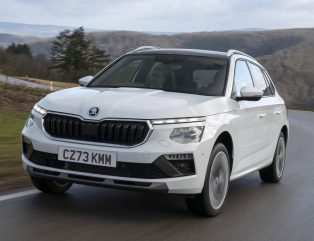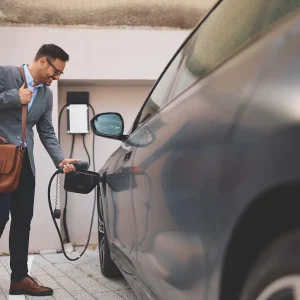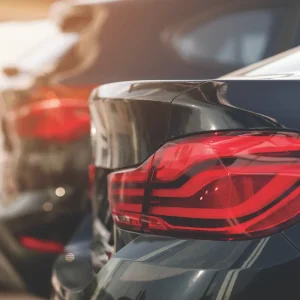
Skoda Kamiq
Skoda’s Kamiq is the entry point to the manufacturer’s three-pronged line-up below the larger Karoq and Kodiaq. More impressive, is that the Kamiq is the best-seller of the three, and Skoda’s second best-selling model overall. Now, after five years, there’s a lightly facelifted version, and Skoda will be hoping for more
of the same.
Most of the updates revolve around the Kamiq’s exterior styling, including a larger front grille, redesigned headlights and tail lights, and a silver rear diffuser, with matrix LED headlights a new option.
Inside, the Kamiq facelift updates centre on new fabrics, and a bigger 8.25in infotainment screen and 8in driver display on entry-level Kamiqs, with the rest of the range fitted with a 9.2in infotainment screen and a 10.25in driver display. There’s also an upgraded climate control panel.
Rear legroom remains one of the most impressive Kamiq interior features – headroom back there is also decent too, even with a sunroof fitted. Elsewhere, the 400-litre boot has a low loading lip and is a practical size – although some rivals are bigger.
Mechanically, three petrol engines are available, a 1.0-litre in 95hp or 116hp versions, or the 150hp 1.5-litre that we’re focusing on here. This 1.5 is also cleverly able to drop from running on four to two cylinders where possible to save fuel.
The Kamiq shares its 31% BIK figure with the Juke, but it’s the Ford and Seat that (just) manage to better this figure at 30%. We’d say any ICE-powered small SUV that’s capable of more than 40mpg is at the top of its game, but this Skoda’s 47.6mpg figure isn’t quite good enough for top honours. Instead that goes to sister Volkswagen Group choice, the Seat Arona.
At £28,255, the Kamiq has the highest P11D figure of this set, but it is in range-topping SE L spec, and the Ford is only just behind, with the Seat in third and the Nissan taking top honours. Despite being worth 40% of its original price after three years, this is only good enough for second place, with Ford’s evergreen Puma taking the crown here. The only other area where the Skoda comes close to topping the set, is SMR, which at £2,050, is just £25 behind the winning Seat. Sadly, despite its modest facelift, this isn’t enough to push the Kamiq into top cost per mile position, but it’s only just behind the winning Ford Puma with its 45.48p figure.
Skoda Kamiq 1.5 TSI SE L
P11D: £28,255
CO2 (tax): 134g/km (31%)
BIK 20/40% a month: £145/£291
Fuel consumption: 47.6mpg
National Insurance: £100
First year VED: £255
Subsequent VED: £165
Engine size/power: 1,498cc/150hp
AFR: 15p
Residual value: 40%
Depreciation: £16,720
Fuel costs: £8,518
SMR: £2,050
Cost per mile: 45.48p
Ford Puma
The fact that the Ford Puma has retained its honours in a sector with many new launches over the past four years, tells you how much we like this car, and it is our current ‘Best Compact SUV.’ Recently facelifted, Puma highlights remain the practical interior, an excellent drive, and the latest driver assistance and safety systems.
This Puma is in near-range-topping ST-Line X spec, with the second highest P11D figure here (£28,165), and surprisingly it hasn’t affected its standing in this set. Its 30% BIK figure is equal best with the Seat, but the Nissan and Skoda are only just behind with 1% more.
More impressive, considering the other models in this set, is the fact that at £11,700 and 42%, it has the highest residuals. On top of this, the Puma has the lowest depreciation. Where the Ford falls down, though, is that it has the highest SMR figure, at £2,557, of the four cars we’re reviewing. Despite this, the high residuals and low depreciation mean the Ford has the lowest cost per mile figure here.
Ford Puma 1.0 Ecoboost 155 ST-Line X
P11D: £28,165
CO2 (tax): 125g/km (30%)
BIK 20/40% a month: £140/£281
Fuel consumption: 50.4mpg
National Insurance: £97
First year VED: £210
Subsequent VED: £165
Engine size/power: 999cc/155hp
AFR: 13p
Residual value: 42%
Depreciation: £16,440
Fuel costs: £8,177
SMR: £2,557
Cost per mile: 45.29p
Nissan Juke
With its distinctive looks and raised stance, the original Nissan Juke helped define the compact SUV sector, attracting many buyers out of their conventional superminis. The current, second-generation version has been with us since 2019 and follows the original Juke’s sense of style, although this is toned down and has more capable underpinnings shared with the Renault Clio amongst others. Inside, because the second-generation Juke is bigger, there’s more space, better-quality trim and plastics, plus an improved infotainment system.
Tekna + is the range-topping Juke, but all are well-equipped with standard DAB radio, plus Bluetooth, USB, and AUX connectivity, with a 4.2in screen, cruise control with speed limiter, lane departure warning, and traffic sign recognition.
The Juke’s closest rival in this set, is the winning Skoda Kamiq. It matches the Skoda with its 31% BiK figure and 134g/km emissions. The reason for its last-place finish, is because it’s got the highest fuel figure (£8,518) along with the Nissan, and the second highest £2,472 SMR figure.
Nissan Juke 1.0 DiG-T Tekna+
P11D: £27,125
CO2 (tax): 134g/km (31%)
BIK 20/40% a month: £140/£280
Fuel consumption: 47.9mpg
National Insurance: £96
First year VED: £255
Subsequent VED: £165
Engine size/power: 999cc/114hp
AFR: 13p
Residual value: 39%
Depreciation: £16,500
Fuel costs: £8,518
SMR: £2,472
Cost per mile: 45.81p
Seat Arona
Seat was relatively early to launch a small SUV, in the form of the Arona back in 2017. It quickly established itself thanks to its decent drive yet was still practical and cheap to run. It was modestly facelifted at the end of 2021.
Despite keener opposition in the form of our current compact SUV favourite, the Ford Puma, the Arona has kept in touch thanks to a tech and quality upgrade for the interior. Gone is the disappointing hard plastic dashboard, to be replaced with a much-improved and higher-quality feel-soft one. At the top, there’s a much bigger 9.2in screen fitted to our Xperience Lux range-topper.
The 110hp 1.0 TSi petrol engine is the most popular fleet choice, with this offering a competitive 36% BIK rate, and up to 51.4mpg WLTP fuel consumption.
The Seat might not be the newest model in this set, but the Arona’s 51.4mpg figure is the best here, placed joint first for NI with the Nissan (£96). The Arona also scores top positions for SMR (£2,025), and fuel cost (£8,017). In fact, if it wasn’t for its depreciation and residual value figures, it would have taken the top spot here. Although not that far behind the others, its 46.50p figure is only good for last place.
Seat Arona 1.0TSI Xperience Lux
P11D: £27,985
CO2 (tax): 126g/km (30%)
BIK 20/40% a month: £145/£291
Fuel consumption: 51.4mpg
National Insurance: £96
First year VED: £210
Subsequent VED: £165
Engine size/power: 999cc/110hp
AFR: 13p
Residual value: 36%
Depreciation: £17,860
Fuel costs: £8,017
SMR: £2,025
Cost per mile: 46.50p





